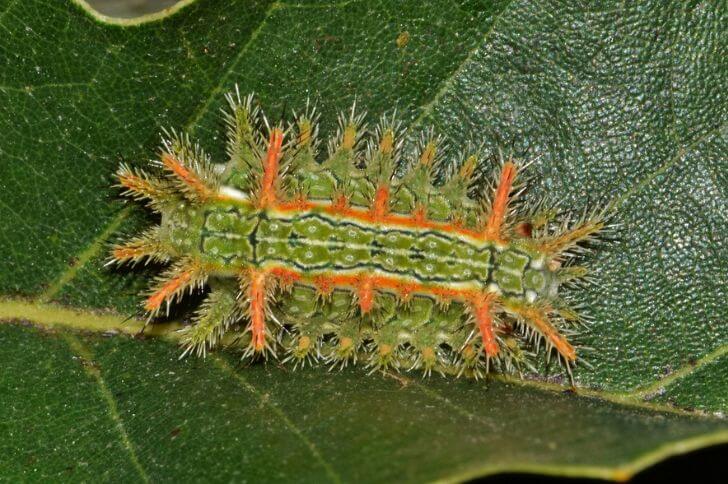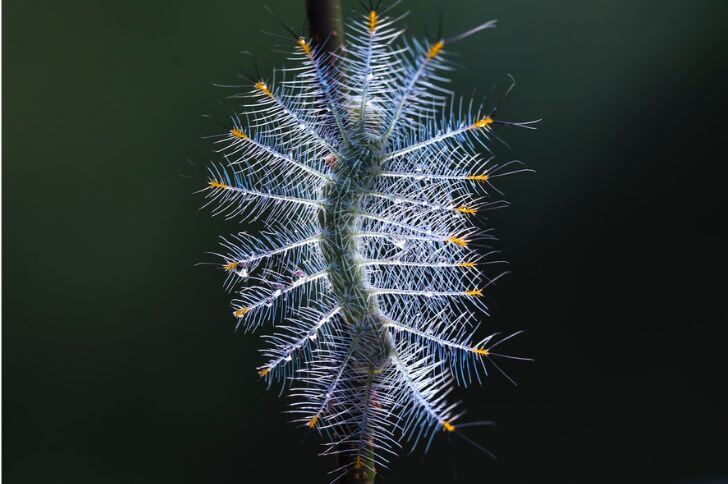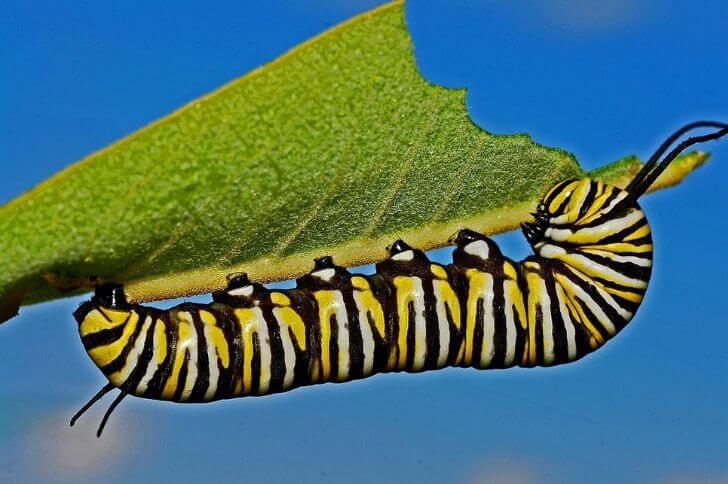5 Blue and Yellow Caterpillars to Know (with Images)
In a world teeming with vibrant and fascinating creatures, few capture the imagination quite like blue and yellow caterpillars. These tiny critters may start off as unassuming larvae, but their striking colors and peculiar behaviors make them stand out in the insect kingdom.
From their mesmerizing hue combinations to their mysterious transformations, these caterpillars are a true wonder of nature. Join me as we delve into the captivating world of blue and yellow caterpillars, uncovering the secrets they hold within their delicate bodies.
List of Blue and Yellow Caterpillars
1. Cecropia Moth Caterpillar
The Cecropia Moth Caterpillar, with its striking blue and yellow appearance during its last instar, is truly a showstopper in the world of insects.
This large caterpillar, measuring up to four inches in length, is known for its vibrant colors, intricate patterns, and unique structures. Its body is adorned with bright blue stripes that contrast beautifully against a background of yellow and black.
What makes the Cecropia Moth Caterpillar even more fascinating is its ability to blend into its surroundings. Despite its eye-catching appearance, it has evolved certain adaptations that allow it to camouflage effectively among the foliage.
With small spine-like structures covering its body and intricate patterns mimicking plant textures, this caterpillar can easily go unnoticed by predators.
Not only are these caterpillars visually stunning, but they also have an interesting life cycle. After hatching from their eggs laid on tree branches during summer months, they spend several weeks feeding voraciously on various leaves
As they grow larger and transform into pupae within silk-woven cocoons hidden among foliage or tree bark crevices; this reveals their incredible survival instincts.
The emergence of adult Cecropia Moths from these cocoons marks the end of another chapter in their remarkable journey.
These moths are known to have beautiful red-orange bodies with white spots on their wingspan that can measure up to six inches across! The females release pheromones to attract males for mating purposes which concludes their short-lived adult life stage.
2. Blue Tiger Moth Caterpillar
Did you know that the blue tiger moth caterpillar is not actually blue? Despite its name, this unique caterpillar is more commonly green or yellow in color.
However, what sets it apart from other caterpillars are the bright blue spiky protrusions on its body. These striking appendages serve as a defense mechanism, deterring potential predators and giving the caterpillar an intimidating appearance.
The blue tiger moth caterpillar can be found in various habitats across North America, including meadows, gardens, and forests.
Unlike many other caterpillars that feed exclusively on a single plant species, this adaptable creature has a diverse diet consisting of leaves from different plants such as dandelions and clover. This broad range of food sources allows them to thrive in a variety of environments.
Interestingly, once the blue tiger moth caterpillar reaches maturity, it spins a cocoon using silk to protect itself during its transformation into an adult. The cocoon is often hidden among leaves or vegetation.
After approximately two weeks, a beautiful adult moth emerges with vibrant orange wings adorned with black spots. This remarkable metamorphosis showcases the incredible journey of this unassuming but captivating creature’s life cycle.
By shedding light on these lesser-known facts about the blue tiger moth caterpillar’s appearance and behavior, we gain a deeper appreciation for nature’s ability to surprise us at every turn.
From its misleading name to its intricate defense mechanisms and impressive adaptability – these aspects all contribute to making it one of our natural world’s fascinating
3. Forest Tent Caterpillar
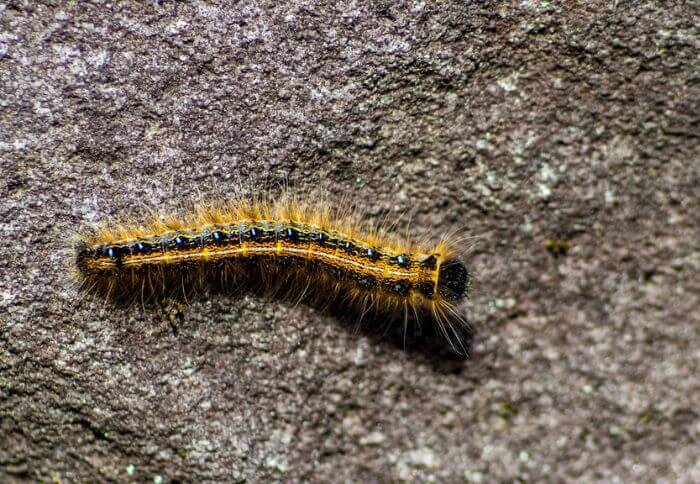
The forest tent caterpillar, also known by its scientific name Malacosoma disstria, is a fascinating species that can be found in the forests of North America. These caterpillars are easily distinguishable by their distinctive blue and yellow markings.
While they may not be as well-known as other caterpillar species, such as the monarch or the swallowtail, forest tent caterpillars have their own unique behaviors and characteristics that make them worth exploring.
One intriguing aspect of these caterpillars is their ability to form communal nests on tree branches. The presence of numerous tents clustered together gives rise to their common name. Inside these silky enclosures, hundreds of larvae gather for protection and undergo their transformative journey into adult moths.
This group living arrangement allows them to communicate with each other through chemical signals and exchange valuable information about food sources and potential threats.
Despite their vibrant appearance, forest tent caterpillars have often been associated with defoliation events in certain regions.
Their voracious appetite for tree leaves can cause significant damage to forests if not regulated naturally or through human intervention.
4. Brown-bordered Owlet Caterpillar
The brown-bordered owlet caterpillar, with its intricate patterns and vibrant colors, is truly a mesmerizing creature. Found in various parts of North America, this caterpillar is named for the striking brown borders that adorn its green body.
Its small size and delicate appearance may deceive some into thinking it is harmless, but don’t be fooled – these owlet caterpillars possess venomous spines that can deliver a painful sting.
One interesting aspect of the brown-bordered owlet caterpillar’s life cycle is its remarkable ability to camouflage itself.
While it may seem like an easy target for predators due to its bright colors, this caterpillar cleverly disguises itself by contorting its body to mimic bird droppings on leaves. This remarkable adaptation helps it blend seamlessly into its surroundings and improves its chances of survival.
Despite their intriguing nature, these owlet caterpillars can be tricky to spot as they tend to feed at night or in the early morning hours when most humans are still asleep.
However, if you happen upon one during your outdoor adventures, take a moment to marvel at this miniature natural wonder and appreciate the impressive adaptations that allow such creatures to thrive in their ecosystems.
5. Atropos Hawk Moth Caterpillar
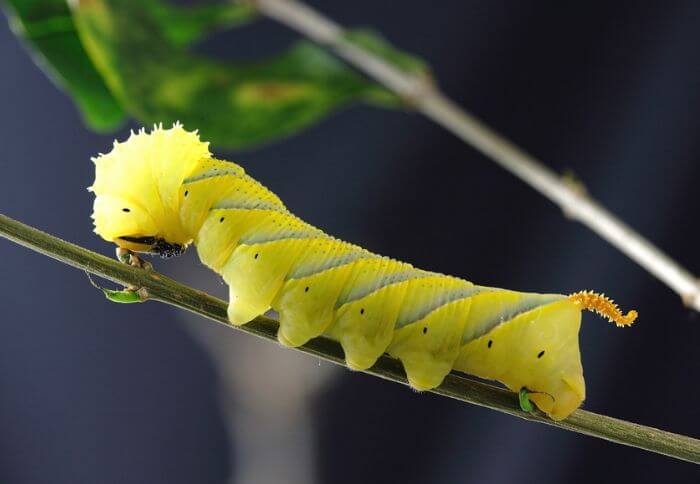
The Atropos Hawk Moth Caterpillar is a unique and intriguing creature that can be found across North America. With its vibrant blue and yellow coloration, it stands out among other caterpillars in the region.
What sets this species apart is its ability to mimic the appearance of a dangerous snake when threatened. The caterpillar has large, black spots along its body that resemble the eyes of a snake, giving off the illusion of danger. This adaptation helps protect it from potential predators and ensures its survival in various environments.
But there’s more to this caterpillar than just its impressive defense mechanism. The Atropos Hawk Moth Caterpillar also boasts intricate patterns and markings on its body, adding to its overall beauty.
It moves in a slithering motion like a snake when disturbed, further enhancing the guise. Beyond aesthetics, this species plays an important role in plant pollination as an adult moth, making it an essential component of ecosystems.
6. Giant Peacock Moth Caterpillar
One of the most visually striking caterpillars in the insect world is the Giant Peacock Moth Caterpillar. This vibrant creature boasts a stunning display of blue and yellow patterns that can captivate even the most casual observer.
Found primarily in Europe and Asia, this species is known for its large size, reaching lengths of up to 8 centimeters.
What sets the Giant Peacock Moth Caterpillar apart from other caterpillars is not just its size and appearance but also its unique defense mechanisms. When threatened, it releases foul-smelling secretions that deter predators, ensuring its survival in a world full of hungry birds and other insects.
Additionally, these caterpillars feature tufts of long spines along their bodies, further protecting themselves from potential dangers.
However, despite their mesmerizing beauty and impressive defense tactics, finding these creatures in their natural habitats can prove to be quite challenging.
Their solitary nature combined with their preference for dense foliage makes them incredibly elusive to spot.
Nevertheless, those lucky enough to observe one in person are rewarded with an unforgettable experience – witnessing one of nature’s most remarkable transformations unfold before their eyes as this little-known caterpillar metamorphoses into a breathtaking moth capable of rivaling even peacocks in terms of grandeur and splendor.
Final Thoughts:
Blue and yellow caterpillars are fascinating creatures that captivate our attention with their unique colors and patterns. They go through a remarkable transformation, from humble caterpillar to beautiful butterfly.
Their vibrant hues serve as a warning to potential predators, signaling their toxicity and ensuring their survival. By learning more about these incredible insects, we can deepen our appreciation for the natural world and the intricacies of its inhabitants.
So next time you encounter a blue and yellow caterpillar, take a moment to observe and marvel at its beauty and significance in the intricate web of life.
source:

Passionate animal enthusiast and skilled writer with a flair for captivating storytelling. With over five years of experience, I have crafted engaging content that sheds light on the fascinating world of animals.
Through my articles, blog posts, and social media campaigns, I strive to raise awareness about conservation efforts and promote a deeper understanding of the natural world.



